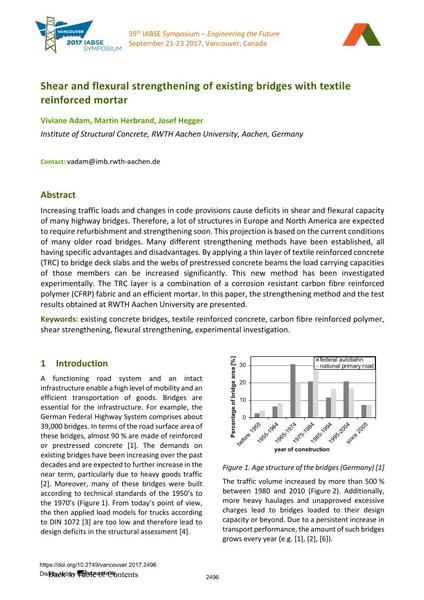Shear and flexural strengthening of existing bridges with textile reinforced mortar

|
|
|||||||||||
Bibliografische Angaben
| Autor(en): |
Viviane Adam
(Institute of Structural Concrete, RWTH Aachen University, Aachen, Germany)
Martin Herbrand (Institute of Structural Concrete, RWTH Aachen University, Aachen, Germany) Josef Hegger |
||||
|---|---|---|---|---|---|
| Medium: | Tagungsbeitrag | ||||
| Sprache(n): | Englisch | ||||
| Tagung: | IABSE Symposium: Engineering the Future, Vancouver, Canada, 21-23 September 2017 | ||||
| Veröffentlicht in: | IABSE Symposium Vancouver 2017 | ||||
|
|||||
| Seite(n): | 2496-2503 | ||||
| Anzahl der Seiten (im PDF): | 8 | ||||
| Jahr: | 2017 | ||||
| DOI: | 10.2749/vancouver.2017.2496 | ||||
| Abstrakt: |
Increasing traffic loads and changes in code provisions cause deficits in shear and flexural capacity of many highway bridges. Therefore, a lot of structures in Europe and North America are expected to require refurbishment and strengthening soon. This projection is based on the current conditions of many older road bridges. Many different strengthening methods have been established, all having specific advantages and disadvantages. By applying a thin layer of textile reinforced concrete (TRC) to bridge deck slabs and the webs of prestressed concrete beams the load carrying capacities of those members can be increased significantly. This new method has been investigated experimentally. The TRC layer is a combination of a corrosion resistant carbon fibre reinforced polymer (CFRP) fabric and an efficient mortar. In this paper, the strengthening method and the test results obtained at RWTH Aachen University are presented. |
||||
| Stichwörter: |
experimentelle Untersuchung TRC
|
||||
